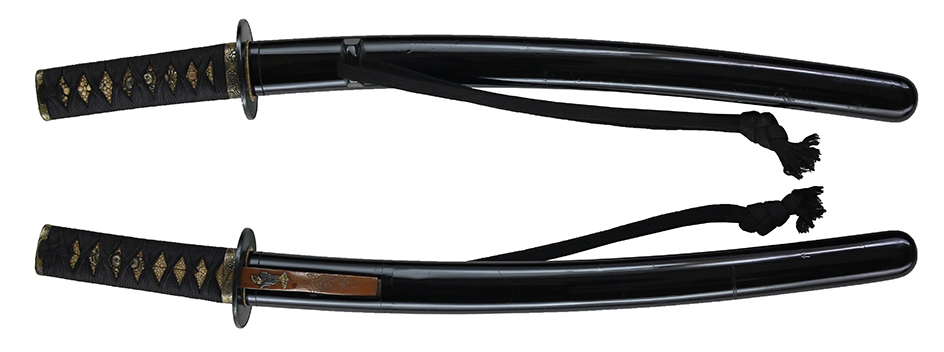Authentic Japanese swords are true masterpieces with an eye for the smallest details. Although some vendors want to make you believe the contrary with a modern mass katana, you will after some research have to conclude that a modern production katana often do not come close to an authentic Japanese sword. In the West the interest in Japanese katana's is increased and demand to buy an authentic Nihonto is slowly increased.
After someone has learned to see the true beauty and perfection that lies beyond to forge a unique katana the fascination will grow.
Thanks to my Budo background (karate and iaido) my personal interest become ever larger and I must conclude that I've become quite addicted in collecting Nihonto.
My growing knowledge concerning Nihonto is a continuous process in which I am always discovering new pieces of information. A nice aspect of my shop is I sometimes temporarily may enjoy a Nihonto before I sell it to someone else.
The reason we still enjoy today those beautiful masterpieces is because Nihonto in Japan were passed from generation to generation. The katana was considered to be the soul of the Samurai and the connection between the Katana and the Samurai was very strong. Basically it was a matter of life or death for the carrier and it is understandable that this was honoured with great respect. The Samurai also had other weapons at his disposal such as a bow, spear, wakizashi and tanto. The katana got the most spiritual interpretation partly because it was his most personal weapon, a bow was used for long distance. Add to this the excellent quality of the Japanese Swords and also it was in a large part of the Japanese history only allowed for Samurai to carry a katana.
I will now quote some tips and explain some basic concepts which are common with judging and handle a Nihonto.
Although most people agree that the origin of the Katana came from China via Korea in the direction of Japan, it only in Japan reached great heights in forging mainly as a result of different conditions in raw materials, philosophy and society construction.
The blades are made in different periods with their own unique characteristics. One of the most important aspects is where the raw materials were mined. But there are more characteristics like the style and shape of the blades. There are different periods including Jokoto (pre 987 AD), Koto (987-1596 a.d.), Shinto (1597-1760 AD), Shinshinto (1760-1876 AD), Gendaito Shinsakuto (~ 1877-1945 AD) and (~ 1946 AD-).
Up to +/- 1600 the iron sand was mined regionally from which the Tamahagane was produced in a Tatara. This period is called the Koto time. Also the invention and acceptance of the tachi based on the curved sword design intended for cutting lies in this era.
From +/- 1600 raw materials exchanged between the different regions and this is called the Shinto period. Shinto means new sword, and the Katana
replaced the Tachi and the wakizashi was introduced. The unification of Japan caused a merger of some of the five traditions. Also the Samurai class is formalized.
Approximately in 1800 began the Shin-Shinto period who ended with the Meij period. Shinshinto was a rejection of the conventional Shinto sword style and a return to fabrication of swords under the Goka Den (five traditions) marks this era.
In 1876, the carrying of weapons in public was prohibited. Due to the disappearance of the Samurai class and this ban it went quickly downhill with the sword smiths. The period in which a Nihonto was forged is often referred with the assessment of a Nihonto and often gives different attributes. Fortunately there were some Smiths who survived and thanks to them we can still find some high quality smiths today.
Of course all Nihonto are hand forged from Tamahagane, which is born in a Tatara from Satetsu (iron sand). The tamahagane is handforged, folded and differential hardened. With these techniques, including folding and hammering, the blades develops a different surface with different structures also called called Jihada. The entire structure and colour of the blade is called Jitetsu. The most important and easy recognizable Jihada are Masame (layers), Itama (wood grain) and Mokume (tree rings). The high carbon steel is hammer folded in the forge with a less modified and lower carbon back content to forge a blade in the forge.
This was done to create maximum benefits from the various properties of high and low carbon pieces, the high carbon was used for the outside, or cutting edge, with very hard and sharp properties and the inside and back with low carbon makes optimal use of the more flexible and absorbent properties. Almost as important as the forging of a blade is the polishing which is very complex and involves sophisticated techniques.
Although there are great similarities with forges that extensively forge much katana's (especially in China) in detail it is impossible to compare these katanas in a way of details, spiritual, cultural and art.
The hand-forged blade is treated with a clay recipe and then heated to a high temperature. The crucial point is Yaki-ire when the blade is gequenched and is quickly cooled down in a reservoir of water.
The time of Yaki ire is determined by the smith who through his experience decides if the heated steel reached the correct temperature.
The thin clay layer on the ha or edge cools down very rapidly and the back or mune often remains something blanker and thus more flexible. In this way a hamon arises on the ha (edge) with a dividing line regard to the Shinogi. This hamon determines a large part of the blades beauty.
After this stage the blades is polished with Japanese stones, and not until now it will be visible what the smith has reached with its forging treatments.
All parts are made by specialists who often have years of experience. The habaki (created by the Habaki-shi), saya (sheath-created by the Saya-shi) and finish (Togi-shi) are hand-made by individual specialists. The Ito (wrapping) on the tsuka (handle) is wrapped on the rayskin covered handle.
Then often rices the question what exactly is a good nagasa or blade. The whole Nagasa should at least be in harmony, with this I am referring on the Suguta, which is the whole shape. The sori (curvature), length, width and thickness has to be right. An important aspect is the Jihada and Jitetsu who let themselves read on the surface of the nagasa. The hamon is also highly appreciated and should be fluent and fit the Nagasa. At different periods there were various hamon techniques popular with aesthetic features.
If you want to judge a Nihonto I recommend to hold the Nihonto in front of you with the right light and watch easily the Jihada, Jitetsu, Hamon and Boshi. As your knowledge progresses you will recognize the Hataraki, this is activity in the hamon. Several characteristics can be viewed as Nie, Nioi, Ashi and Chikei. The diversity it is very large and there are many Japanese names for various activities. Before you can indicate this well you need a lot of knowledge and training material.
A good finishing polishing (Shiage-Togi) makes sure the activity in the blade will be visible and for that matter you can speak about a loupe watching into the steel. Each nihonto has aspects from which you can learn and often it is the case how higher a katana is ranked the more asepcts are in it that you can study and learn how the Smith is pursuing his strive for perfection. A good finish takes care that the Hada and Hamon there comes out as it was intended by the Smith.
The hada also provides a good indication of the experience and skills of the Smith and also is sometimes a good indicator at which school a Smith can be classified.
A great indicator for the age is the nakago on which you can find the signature or Mei of the smith. All these aspects together with the interpretation of the condition of the Nakago, with this I am referring to corrosion, gives an indication of the period, school and Smith.
There are many mumei (unsigned) Nihonto and these are often also in good condition and can also be classified into a period, smith and school. Pretty red rust or vesicle could indicate a fake blade and those are chemically made.


